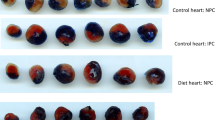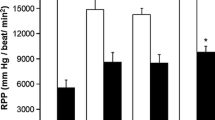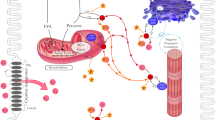Abstract
The purpose of this study was to investigate the effects of L-carnitine on the hemodynamic parameters of Langendorff hearts. Isolated rat hearts were perfused with various solutions containing high or low concentrations of fatty acids, additional glucose or no glucose, and L-carnitine or no L-carnitine. The most interesting part of the experiments was the behaviour of the hearts in the reperfusion period after no-flow ischemia of 20 min. The results were: (1) With glucose and high fatty acid concentrations the hearts showed an improved recovery of the left ventricular functions in the reperfusion period compared with low fatty acid concentrations. Without glucose the left ventricular pressure is much lower in the reperfusion period. (2) Addition of L-carnitine improved the recovery of the ischemically damaged hearts. This improvement is especially impressive at low fatty acid concentrations. L-carnitine addition at high fatty acid concentrations but without glucose strongly improved reperfusion behaviour. (3) The coronary flow is increased by 2 experimental conditions: (i) perfusion at low levels of fatty acids, carnitine and with glucose and (ii) high levels of fatty acids and carnitine but without glucose. These findings suggest that supplementation of L-carnitine has a beneficial effect on the isolated heart under various conditions, and possibly on specific human heart diseases.
Similar content being viewed by others
References
Lopaschuk GD, Saddik M: The relative contribution of glucose and fatty acids to ATP production in hearts reperfused following ischemia. Mol Cell Biochem 116(1–2): 111–116, 1992
Liedtke AJ, De Maison L, Eggleston AM, Cohen LM, Nellis SH: Changes in substrate metabolism and of excess fatty acids in reperfused myocardium. Circ Res 62: 535–562, 1988
Duan J, Karmazyn M: Effect of D,L-carnitine on the response of the isolated heart of the rat to ischaemia and reperfusion: Relation to mitochondrial function. Br J Pharmacol 98: 1319–1327, 1989
Gürtler A-K, Löster H: Carnitin und seine Bedeutung bei der Pathogenese und Therapie der Herz-und Kreislauferkrankungen, Ponte Press, Bochum, 1996, 116 pp
Katz KM, Messineo FC: Lipid membrane interactions and the pathogenesis of ischemic damage in myocardium. Circ Res 48: 1–16, 1981
Lopaschuk GD, Wall SR, Olley PM, Davies NJ: Etomoxir, a carnitine palmitoyltransferase I inhibitor, protects hearts from fatty acid-induced ischemic injury independent of changes in long chain acylcarnitine. Circ Res 63: 1036–1043, 1988
Opie LH: Role of carnitine in fatty acid metabolism of normal and ischemic myocardium. Am Heart J 97: 375–388, 1979
Paulson DJ, Shug AL: Inhibition of the adenine nucleotide translocator by matrix-localized palmityl-CoA in rat heart mitochondria. Biochim Biophys Acta 766: 70–76, 1984
Paulson DJ, Traxler J, Schmidt M, Noonan J, Shug AL: Protection of the ischaemic myocardium by L-propionylcarnitine: Effects on the recovery of cardiac output after ischaemia and reperfusion, carnitine transport, and fatty acid oxidation. Cardiovasc Res 20: 536–541, 1986
Broderick TL, Quinney HA, Lopaschuk GD: Carnitine stimulation of glucose oxidation in the fatty acid perfused isolated working heart. J Biol Chem 267: 8162–8170, 1992
Lopaschuk GD, McNeill, McVeigh JJ: Glucose oxidation is stimulated in reperfused hearts with the carnitine palmitoyltransferase I inhibitor, Etomoxir. Mol Cell Biochem 188: 175–179, 1989
Lopaschuk GD, Spafford MA, Davies NJ, Wall RS: Glucose and palmitate oxidation in isolated working rat hearts reperfused after a period of transient global ischemia. Circ Res 6: 546–553, 1990
Stanlay WC, Lopaschuk GD, Hall JL, McCormack JG: Regulation of myocardial carbohydrate metabolism under normal and ischaemic conditions. Potential for pharmacological interventions. Cardiovasc Res 33: 243–257, 1997
De Jong JW, Ferrari R (eds): The carnitine system: A new therapeutical approach to cardiovascular diseases, Kluwer Academic Publishers, Dordrecht, Boston, London, 1995, pp 393
Ferrari R, Dimauro S, Sherwood G (eds): L-carnitine and its role in medicine: From function to therapy, Academic Press London, San Diego, New York, Boston, Sydney, Tokyo, Toronto, 1992, pp 433
Shug AL, Thomsen JH, Folts JD, Bittar N, Klein MI, Koke JR, Huth PJ: Changes in tissue levels of carnitine and other metabolises during myocardial ischemia and anoxia. Arch Biochem Biophys 187: 25–33, 1978
Broderick TL, Quinney HA, Barker C, Lopaschuk GD: Beneficial effect of carnitine on mechanical recovery of rat hearts reperfused after transient period of global ischemia is accompanied by stimulation of glucose oxidation. Circ 87: 972–981, 1993
Kotaka K, Miyazaki Y, Ogawa K, Satake T, Kitazawa M, Sugiyama S, Ozawa T: Protective effects of carnitine and its derivatives against free fatty acid-induced mitochondrial dysfunction. J Appl Biochem 3: 328–336, 1981
Liedtke AJ, Nellis SH, Copenhaver G: Effects of carnitine in ischemic and fatty acid supplemented swine hearts. J Clin Invest 64: 440–447, 1979
Liedtke AJ, Nellis SH, Whitesell LF: Effects of carnitine isomers on fatty acid metabolism in ischemic swine hearts. Circ Res 48: 859–866, 1981
Liedtke AJ, Nellis SH, Whitesell LF, Mahar CQ: Metabolic and mechanical effects using L-and D-carnitine in working swine hearts. Am J Physiol 243: H691–H697, 1982
Liedtke AJ, Vary TC, Nellis SH, Fultz CW: Properties of carnitine incorporation in working swine hearts. Effects of coronary flow, ischemia, and excess fatty acids. Circ Res 50: 767–774, 1982
Neely JR, Garber D, McDonough K, Idell-Wenger J: Relationship between ventricular function and intermediates of fatty acid metabolism during myocardial ischemia: Effects of carnitine. In: Ischemic Myocardium and Antianginal Drugs, Raven Press, New York, 1979, pp 225–234
Silverman NA, Schmitt G, Vishwanath M, Feinberg H, Levitzky S: Effect of carnitine on myocardial function and metabolism following global ischemia. Ann Thorac Surg 40: 20–24, 1985
Suzuki Y, Kamikawa T, Kobayashi A, Masamura Y, Yamazaki N: Effects of L-carnitine on tissue levels of acyl carnitine, acyl coenzyme A and high energy phosphate in ischemic dog hearts. Jpn Circ J 45: 687–694, 1981
Gmeiner R, Apstein CS, Brachfeld N: Effect of palmitate on hypoxic cardiac performance. J Mol Cell Cardiol 7: 227–235, 1975
Paulson DJ, Schmidt MJ, Romens J, Shug AL: Metabolic and physiological differences between zero-flow and low-flow ischemia: Effects of L-acetylcarnitine. Basic Res Cardiol 79: 551–561, 1984
Vik-Mo H, Mjos OD: Influence of free fatty acids on myocardial oxygen consumption in intact dogs. Am J Cardiol 48: 361–365, 1981
Ichihara K, Neely JR: Recovery of ventricular function in reperfused ischemic rat hearts exposed to fatty acids. Am J Physiol 249: H492–H497, 1985
Da Torre SD, Creer MH, Pogwizd SM, Corr PB: Amphipathic lipid metabolites and their relation to arrhythmogenesis in the ischemic heart. J Mol Cell Cardiol 23 (Suppl. 1): 11–22, 1991
Heathers GP, Su C-M, Adames VR, Higgins AJ: Reperfusion-induced accumulation of long-chain acylcarnitines in previously ischemic myocardium. J Cardiovasc Pharmacol 22: 857–862, 1993
Lopaschuk GD, Warmbolt RB, Barr RL: An imbalance between glycolysis and glucose oxidation is a possible explanation for the detrimental effects of high levels of fatty acids during aerobic reperfusion of ischemic hearts. J Pharmacol Exp Ther 264: 135–144, 1993
Mickle DAG, Del Nido PJ, Wilson GJ, Harding RD, Romaschin AD: Exogenous substrate preference of the postischemic myocardium. Cardiovasc Res 20: 256–263, 1986
Renström B, Liedtke JA, Nellis SH: Mechanisms of substrate preference for oxidative metabolism during early myocardial reperfusion. Am J Physiol 259: H317–H323, 1990
Van der Vusse GJ, Glatz JFC, Stam HCG, Reneman RS: Fatty acid homeostasis in the normoxic and ischemic heart. Phys Rev 72: 881–940, 1992
Abdel-aleem S, Nada MA, Sayed-Ahmed M, Hendrickson SC, St-Louis J, Walthall HP, Lowe JE: Regulation of fatty acid oxidation by acetyl-CoA generated from glucose utilization in isolated myocytes. J Mol Cell Cardiol 28: 825–833, 1996
Finegan BA, Clanachan AS, Coulson CS, Lopaschuk GD: Adenosine modification of energy substrate use in isolated hearts perfused with fatty acids. Am J Physiol 262: H1501–H1507, 1992
Hearse DJ, Shattock MJ, Manning AS, Braimbridge MV: Protection of the myocardium during ischemic arrest: Possible toxicity of carnitine in cardioplegic solutions. Thorac Cardiovasc Surg 28: 253–258, 1980
Paulson DJ, Schmidt MJ, Traxler JS, Ramacci MT, Shug AL: Improvement of myocardial function in diabetic rats after treatment with L-carnitine. Metabolism 33: 358–363, 1984
Paulson DJ, Shug AL: Effects of carnitine on the ischemic arrested heart. Basic Res Cardiol 77: 460–463, 1982
Idell-Wenger JA, Grotyohann LW, Neely JR: Coenzyme A and carnitine distribution in normal and ischemic hearts. J Biol Chem 253: 4310–4318, 1978
Ferrari R, Ciampalini G, Agnoletti G, Cargnoni A, Ceconi C, Visioli O: Effect of L-carnitine derivatives on heart mitochondrial damage induced by lipid peroxidation. Pharmacol Res Commun 20: 125–132, 1988
Subramanian R, Plehn S, Noonan J, Schmidt M, Shug AL: Free radicalmediated damage during myocardial ischemia and reperfusion and protection by carnitine esters. Z Kardiol 76 (Suppl. 5): 41–45, 1987
Davies NJ, Schulz R, Olley PM, Strynadka KD, Panas DL, Lopaschuk GD: Lysoplasmentylethanolamine accumulation in ischemic/reperfused isolated fatty acid-perfused hearts. Circ Res 70: 1161–1168, 1992
Piper HM, Das A: Detrimental actions of endogenous fatty acids and their derivatives. A study of ischemic mitochondrial injury. Bas Res Cardiol 82 (Suppl. 1): 187–196, 1987
Van Bilsen M, Van der Vusse GJ, Willemsen PH, Coumans WA, Reneman RS: Fatty acid accumulation during ischemia and reperfusion: Effects of pyruvate and POCA, a carnitine palmitoyltransferase I inhibitor. J Mol Cell Cardiol 23: 1437–1447, 1991
Van der Vusse GJ, Prinzen FW, Van Bilsen M, Engels W, Reneman RS: Accumulation of lipids and lipid-intermediates in the heart during ischemia. Basic Res Cardiol 82: 157–167, 1987
Nagao B, Kobayashi A, Yamazaki N: Effects of L-carnitine on phospholipids in the ischemic myocardium. Jpn Heart J 28: 243–251, 1987
Saddik M, Lopaschuk GD: Myocardial triglyceride turnover during reperfusion of isolated rat hearts subjected to a transient period of global ischemia. J Biol Chem 267: 3825–3831, 1992
Ronca G, Ronca F, Yu G, Zucchi R, Bertelli A: Protection of isolated perfused working rat hearts from oxidative stress by exogenous Lpropionyl carnitine. Drugs Exp Clin Res 18(11–12): 475–480, 1992
Packer L, Valenza M, Serbinova E, Starke-Reed P, Frost K, Kagan V: Free radical scavenging is involved in the protective effect of L-Propionyl carnitine against ischemia reperfusion injury of the heart. Arch Biochem Biophys 288: 533–537, 1991
Author information
Authors and Affiliations
Rights and permissions
About this article
Cite this article
Lõster, H., Punzel, M. Effects of L-carnitine on mechanical recovery of isolated rat hearts in relation to the perfusion with glucose and palmitate. Mol Cell Biochem 185, 65–75 (1998). https://doi.org/10.1023/A:1006891208220
Issue Date:
DOI: https://doi.org/10.1023/A:1006891208220




